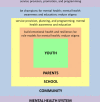Mental health of South Asian youth in Peel Region, Toronto, Canada: a qualitative study of determinants, coping strategies and service access
- PMID: 29101148
- PMCID: PMC5695456
- DOI: 10.1136/bmjopen-2017-018265
Mental health of South Asian youth in Peel Region, Toronto, Canada: a qualitative study of determinants, coping strategies and service access
Abstract
Objectives: This qualitative study set out to understand the mental health challenges and service access barriers experienced by South Asian youth populations in the Peel Region of Toronto, Canada.
Setting: In-depth semistructured interviews were carried out with South Asian youth living in Peel Region (Mississauga, Brampton and Caledon), a suburb of Toronto, Canada, home to over 50% of Ontario's South Asian population.
Participants: South Asian youth (n=10) engaged in thoughtful, candid dialogue about their mental health and service access barriers.
Primary and secondary outcome measures: Qualitative interview themes related to mental health stressors and mental health service access barriers experienced by youth living in Peel Region were assessed using thematic analysis.
Results: South Asian youth face many mental health stressors, from intergenerational and cultural conflict, academic pressure, relationship stress, financial stress and family difficulties. These stressors can contribute to mental health challenges, such as depression and anxiety and drug use, with marijuana, alcohol and cigarettes cited as the most popular substances. South Asian youth were only able to identify about a third (36%) of the mental health resources presented to them and did not feel well informed about mental health resources available in their neighbourhood.
Conclusions: They offered recommendations for improved youth support directed at parents, education system, South Asian community and mental health system. Institutions and bodies at all levels of the society have a role to play in ensuring the mental health of South Asian youth.
Keywords: immigrant populations; mental health; mental health service access; qualitative research; racialized populations; south asian youth.
© Article author(s) (or their employer(s) unless otherwise stated in the text of the article) 2017. All rights reserved. No commercial use is permitted unless otherwise expressly granted.
Conflict of interest statement
Competing interests: None declared.
Figures


Similar articles
-
South Asian youth mental health in Peel Region, Canada: Service provider perspectives.Transcult Psychiatry. 2023 Apr;60(2):368-382. doi: 10.1177/13634615221119384. Epub 2022 Sep 13. Transcult Psychiatry. 2023. PMID: 36113160 Free PMC article.
-
The role of sport in coping and resilience amongst resettled South Sudanese youth in Australia.Health Promot Int. 2022 Apr 29;37(2):daab100. doi: 10.1093/heapro/daab100. Health Promot Int. 2022. PMID: 34409454
-
Stakeholder views on factors influencing the wellbeing and health sector engagement of young Asian New Zealanders.J Prim Health Care. 2016 Mar;8(1):35-43. doi: 10.1071/HC15011. J Prim Health Care. 2016. PMID: 27477373
-
Understanding the factors related to how East and Southeast Asian immigrant youth and families access mental health and substance use services: A scoping review.PLoS One. 2024 Jul 15;19(7):e0304907. doi: 10.1371/journal.pone.0304907. eCollection 2024. PLoS One. 2024. PMID: 39008453 Free PMC article.
-
Involving South Asian patients in clinical trials.Health Technol Assess. 2004 Oct;8(42):iii, 1-109. doi: 10.3310/hta8420. Health Technol Assess. 2004. PMID: 15488164 Review.
Cited by
-
Factors Affecting South and East Asian Immigrants' Access to Mental Health Services in Canada: A Scoping Review.J Immigr Minor Health. 2025 Aug 21. doi: 10.1007/s10903-025-01757-z. Online ahead of print. J Immigr Minor Health. 2025. PMID: 40839194 Review.
-
Planting the seeds for success: A qualitative study exploring primary healthcare providers' perceptions about medical cannabis.PLoS One. 2024 Mar 7;19(3):e0295858. doi: 10.1371/journal.pone.0295858. eCollection 2024. PLoS One. 2024. PMID: 38451984 Free PMC article.
-
The Traumatizing Impact of Racism in Canadians of Colour.Curr Trauma Rep. 2022;8(2):17-34. doi: 10.1007/s40719-022-00225-5. Epub 2022 Mar 24. Curr Trauma Rep. 2022. PMID: 35345606 Free PMC article. Review.
-
South Asian youth mental health in Peel Region, Canada: Service provider perspectives.Transcult Psychiatry. 2023 Apr;60(2):368-382. doi: 10.1177/13634615221119384. Epub 2022 Sep 13. Transcult Psychiatry. 2023. PMID: 36113160 Free PMC article.
-
"Think positive and don't die alone" - Foreign-born, South Asian older adults' perceptions on healthy aging.Int J Qual Stud Health Well-being. 2023 Dec;18(1):2253576. doi: 10.1080/17482631.2023.2253576. Int J Qual Stud Health Well-being. 2023. PMID: 37691478 Free PMC article.
References
-
- Statistics Canada. (2014). Immigration and ethnocultural diversity in Canada (Catalogue no: 99-010-X). http://www12.statcan.gc.ca/nhs-enm/2011/as-sa/99-010-x/99-010-x2011001-e...
-
- Islam T, Selvaratnam I, Shan N. Building an effective South Asian health strategy in Ontario: report for council of agencies serving South Asians. Toronto, Ontario, 2013.
-
- National Institute of Mental Health. (2001). Blueprint for change: research on child and adolescent mental health. https://www.nimh.nih.gov/about/advisory-boards-and-groups/namhc/reports/...
-
- World Health Organization. Prevention of mental disorders: effective interventions and policy options. Geneva: World Health Organization, 2004. http://www.who.int/mental_health/evidence/en/prevention_of_mental_disord....
MeSH terms
LinkOut - more resources
Full Text Sources
Other Literature Sources
Medical
